Jan Gradon is one of two main organizers (Jarek Struczynski is the other one) for the largest international jousting tournament in Poland, Turniej Króla Jana III Sobieskiego na Zamku w Gniewie. Outside of Poland, the joust is generally referred to as the Tournament of King John III at Gniew Castle. Jan graciously agreed to be interviewed about this year's 23rd annual tournament.
Hello Jan, please tell us a little about yourself.
I’ve been involved in historical re-enactment since 1996/7, but at first it was not that "historical". I got more into it around 2001, when I first traveled to England for the Battle of Tewkesbury and other events abroad, and then when I joined the Society of St. Michael Archangel (TaŚMA) in 2004 and my equestrian re-enactment group Xiazeca Druzyna in 2005.
With the group, we portray many periods, from Normans through 13th century knights and Rus warriors, early 15th century with the battle of Tannenberg, mid/late 15th century (we started jousting roughly in 2006/7), 17th century with Polish national cavalrymen and Finninsh Reiters, 2nd Ulhan Regiment of Grand Duchy of Warsaw from the Napoleonic Times to Polish cavalrymen of WWI. We also have a horse archery team within our group, that participates in horse archery contests. In the plans there are Romans too. The group trains due to massive help from our stables Pa-Ta-Taj near Warsaw. They train us also in "normal" riding – dressage, horse jumping, etc.
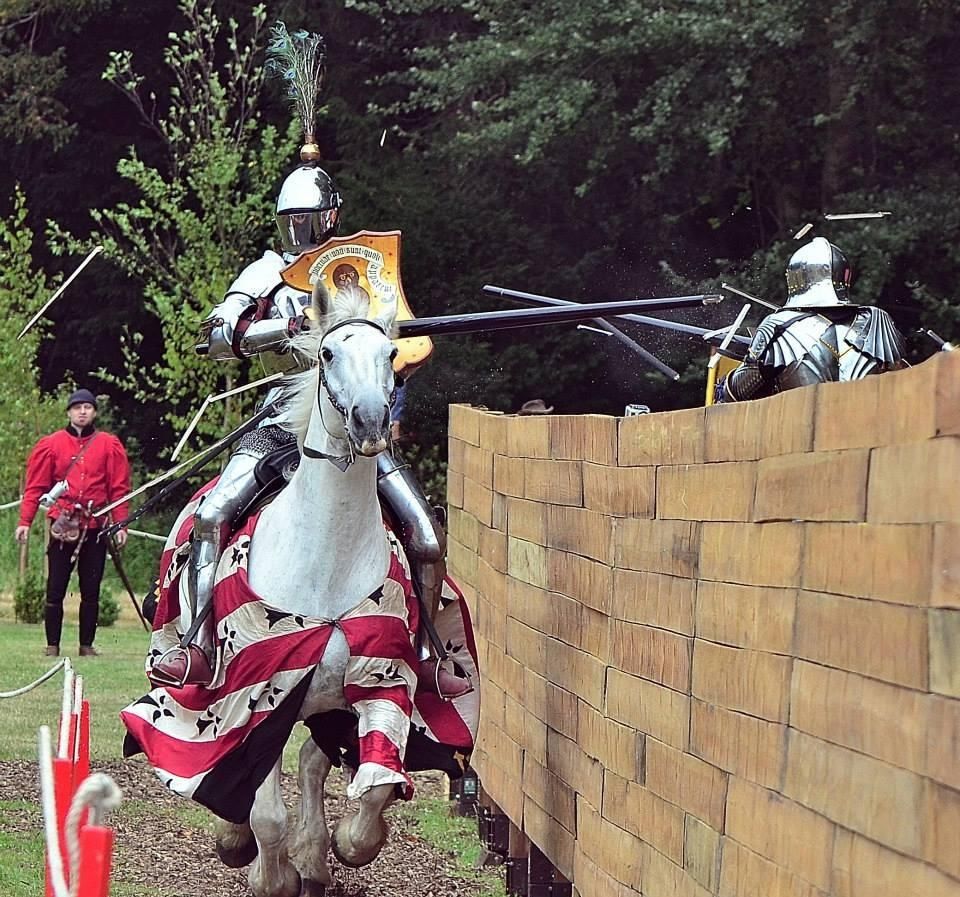
Jan Gradon, riding Briar, jousts Mark Caple at Arundel International Tournament 2013. In the bottom left is Jan's friend and squire, armourer Tomek Samula(photo by Richard Pearn)
From my past experience, the best equestrian memories I have are: Hastings 2006 where we were riding in Dom Sewell’s conroy, and I was riding his horse George [a 'conroy' is a name for a Norman cavalry troop]; my first international joust in Gniew Castle in 2008; winning of Tournament of the Phoenix 2011, and second place in 2013; Le Tournoi du Lys d'Argent in Canada in 2012 where I was unhorsed; and getting into the final (and losing by 1 point as a team, and receiving 2nd individual score) at Arundel International Tournament last year.
Besides jousting I do skiing in winter and do quite a bit of wargaming and painting miniatures. I enjoy a family life with my wife Ula and two daughters, Marysia and Zosia, and our border collie Gibon.
When and how did the Tournament of King John III get started?
The Tournament of King John III started in Gniew Castle in 1992. In 1994 the first mounted tournaments were organized, but at that time they were mainly for a show and only Mounted Skill at Arms contests. Twenty years ago, no one thought of doing jousting, as historical re-enactment was just starting in Poland. In 2007 the first jousting tournament was held, and since then it has grown bigger with higher equipment standards. This year it was the 23rd edition of the event, and the second tournament affiliated with WJT.
What makes Zamek Gniew a good location for a jousting tournament?
First of all, Zamek Gniew is a real castle, so it is always better to joust on a historical site. Secondly, it is an ideal place to organize an international tournament as it has everything on site: a four star hotel where competitors stay, a restaurant where they are fed, a hotel for all the ground and stable crew, a permanent tilt yard with recently covered stands for the public, permanent stables, armoury for the competitors and a fully equipped party hall to have fun in the evenings.
Who is allowed/invited to watch the tournament?
The tournament is open for the public, so anyone can come. On Fridays we usually hold training sessions, and they are free to watch. Saturday and Sunday are ticketed, but the prices are not very high, and as far as I know, residents of Gniew have a discount. There was a limited advertising this year, but we had around 2500-2800 spectators.
How did you become involved with organizing this year's tournament?
I was active around the Tournament since 2008 or 2009. Having traveled with Jarek Struczynski to various international events, we saw many things that we could change and include in our tournament. The first tournaments were more in the sport format with competitors in equipment from different periods (i.e. 14th century jousting with 15th century). Having participated in the Tournament of the Phoenix 2011, I came to an idea of organizing a strictly 15th century tournament in a similar format, where competitors have to participate in many contests to get the final prize. I shared that idea with Jarek, who approved it. I divided the work with Jarek. He and his team organized everything on site, preparing the premises, and I must admit they did an enormous job. My part was to organize and arrange everything with the competitors and ground crew.
In 2013, we organized the first tournament affiliated with WorldJoust Tournaments(WJT) and the International Jousting League(IJL) which involved 12 competitors! Unfortunately the weather was terrible, and not everything went smoothly. This year our second WJT tournament was moved in time to the end of June. The weather was perfect, and we were able to run all the contests.
How was the tournament organized this year?
This year we ran a team tournament with four international teams: England with Steve Mallett and Sean George, Norway with Petter Ellingsen and Per Estein Prois-Rohjell, Burgundy with Wouter Nicolai and Jeff Hedgecock, and last but not least, Poland with Michał Ruda and Adam Firyn.
First we held a Mounted Skill at Arms(MSA) competition. This was just for the MSA prize and the scores were not counted towards the team score. The MSA was won by Steve Mallett from team England.
For the Team prize, we were to count scores from Jousting (overall 6 sessions), mounted melee and crossbow. However, because the competitors did not have a chance to practice the crossbow before the contest, in the end we made it an individual competition that did not count towards the overall score.
As for jousting, we had each of the teams jousting with all the other teams. In each session, one team was jousting with another, and each competitor was to make 3 passes with each competitor from the other team. The scores were counted depending on the area hit (shield, armour), and breakage (attaint, full break). The Lady of Honour and the other Ladies could add 1 or 2 extra points to a total score of a team or individual if they liked his riding, behavior etc...
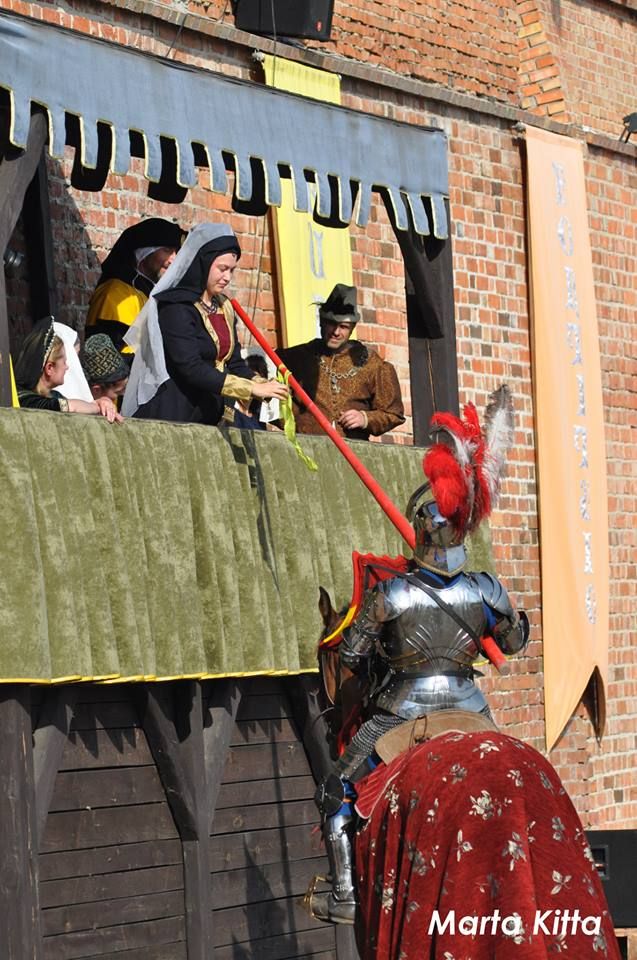
Lady of Honour Viktoriya Borisova wraps a token around the lance of Michel Ruda
(photo by Marta Kitta)
The mounted melee was watched by the Marshall, Knight of Mercy and Court of Ladies, and scores were applied under their opinion. In the end, all scores were put together, and England became the Team winner, Petter Ellingsen earned the Individual title, and Michał Ruda won the crossbow competition.
What can you tell me about the horses that were ridden in the tournament?
All the horses this year were provided by the Castle crew and Krystian Mróz, who was the Stable Master. They were various breeds, from Trakehner, Silesian, Polish Halfbred, and Shire cross breeds.
What were some of the most exciting/interesting moments during the tournament?
There were a lot of good, and strong hits. Quite a few lances broke in their solid parts. I must say that I cannot choose one exciting moment, as I’m very happy with the event as a whole.
Did anything exciting/interesting happen before or after the tournament?
On Thursday prior the event, we had a nice party during the day with a few drinks and laughs, and then Jarek Struczynski ordered us to mount up. Steve Mallett, Jeff Hedgecock, Sean George, as well as the Gniew team and I were dressed in 17th century Polish costumes, and we went for a ride onto the fields and forests on the banks of the Vistula River. Everything began calmly, and then Jarek ordered a flat out gallop. I hope this will be well remembered.
On Friday we had an excursion to Marienburg Castle – the capital of the Teutonic Order, which in my opinion is one of the most beautiful castles in Europe.
We also held a bareback melee, where we rode just in pants with no saddles, and were fighting with softer maces, and grappling was allowed. It did hurt a bit, but it was fun!
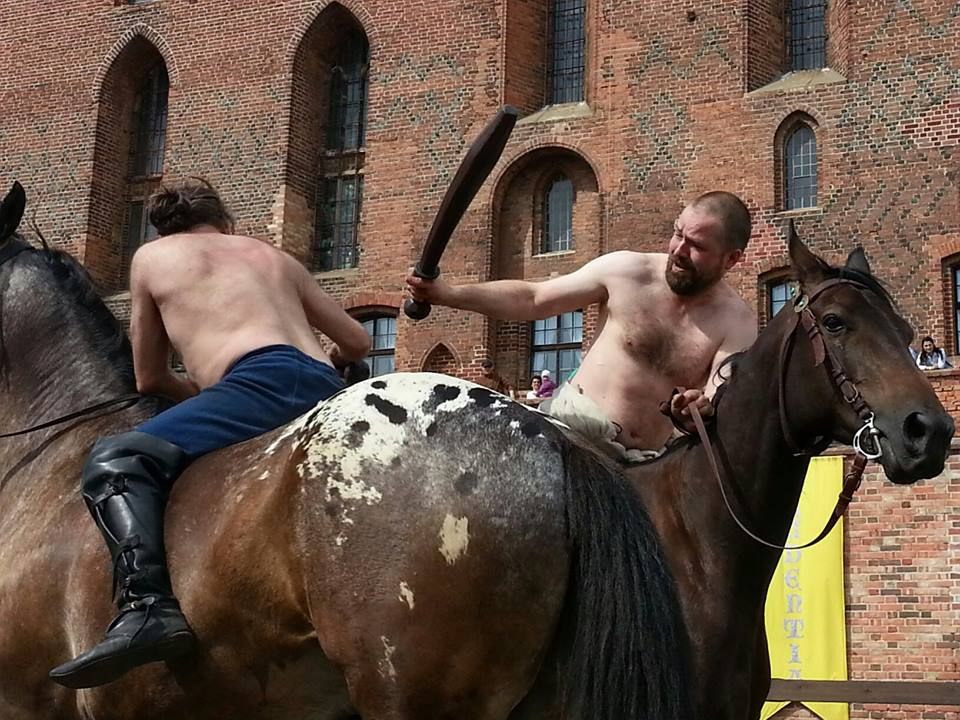
Luc Petillot(left) and Jan Gradon(right) compete in the bareback melee
(photo by Martin Hagen Johnsen)
After the Tournament, we also had a Mass with a Gregorian choir in the Castle’s chapel.
What can you tell me about the night jousting that took place by torchlight this year?
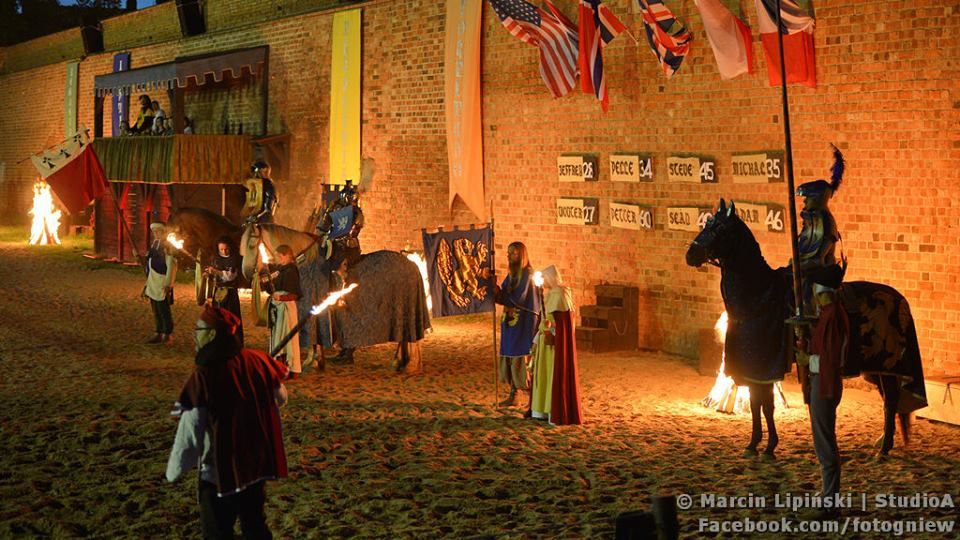
Jan Gradon, Luc Petillot and Adam Ałaszewski await the beginning of the Tournament of the Golden Rose(photo by StudioA)
It was not a part of the competition. We organize it annually as the Tournament of the Golden Rose. There is a local legend about a Golden Rose and its Protector. In the tournament, knights joust to get the Golden Rose, and the winner has to duel the Protector. This year we had Luc Petillot (Knight of Mercy during the day competition), Adam Ałaszewski from Gniew, and me as the knights, and Jarek Struczynski as the Protector of Golden Rose. It was a show, but the jousting was real. All done with bonfires, torches and nice music. I was very happy to do it, as I could try my new armour before this season (btw, huge thanks to Pelle for letting me use his helmet).
What is unique about the Tournament of King John III?
As I said to the Competitors during the briefing on Friday evening, the Tournament is mainly a social event, where people from different countries and cultures can meet, talk, have fun and break some lances. Jousting is a crucial part of the event, but it is very important to have fun. We definitely had fun… especially on Saturday night!
How does the tournament vary each year? What are some of the ways the tournament was organized in previous years?
We change the format annually. In the past it was mostly a foot combat. Then when the jousting started, we change from individual, to team, change the rules, etc..., but the spirit stays the same.
What would you like to say about/to this year's participants?
This year we had some Competitors that participated in the past (Jeff, Steve, Petter, Michal and Adam), and two new ones – Sean and Pelle.
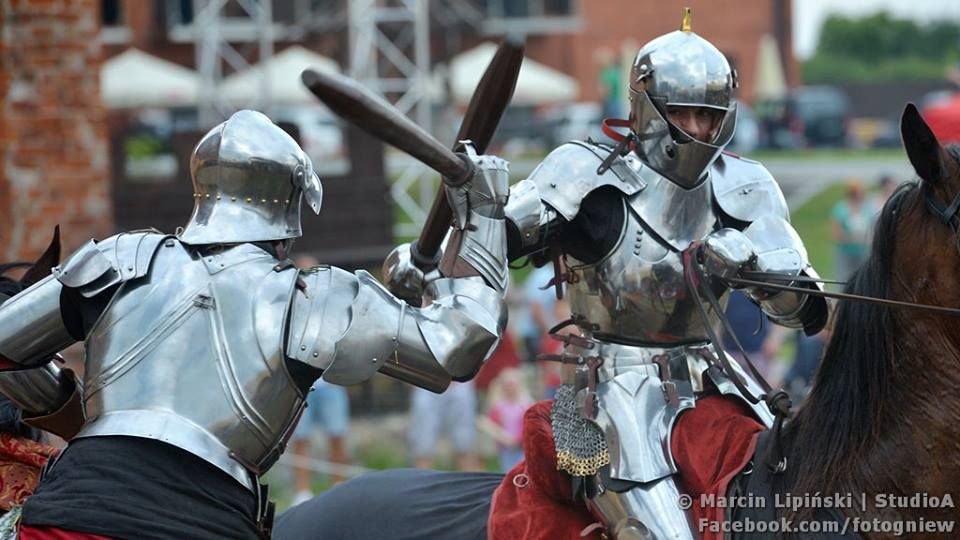
Per Estein Prois Rohjell(aka Pelle) and Sean George exchange blows in the mounted melee
during their first competition at Gniew Castle(photo by StudioA)
The crew was Viktoriya Borisova as the Lady of Honour; Luc Petillot as Knight of Mercy; Jarek Struczynski as Field Coordinator; Stanislaw Szmit as the Herald; Krystian Mróz as Stable/Horse Master; Jakub Grybek, Leszek Struczyński, Darek Ostaszewski, Paweł Piotrowski as scoring judges; squires from Chełmno and Gniew; and me as the Marshal.
What are your hopes/plans for future tournaments at Zamek Gniew?
We will talk about it after this season ends. Next is Arundel International Tournament, where Jarek Struczynski and I will joust as team Kingdom of Poland! Wish us luck!
Best of luck at Arundel and in all your future jousts!
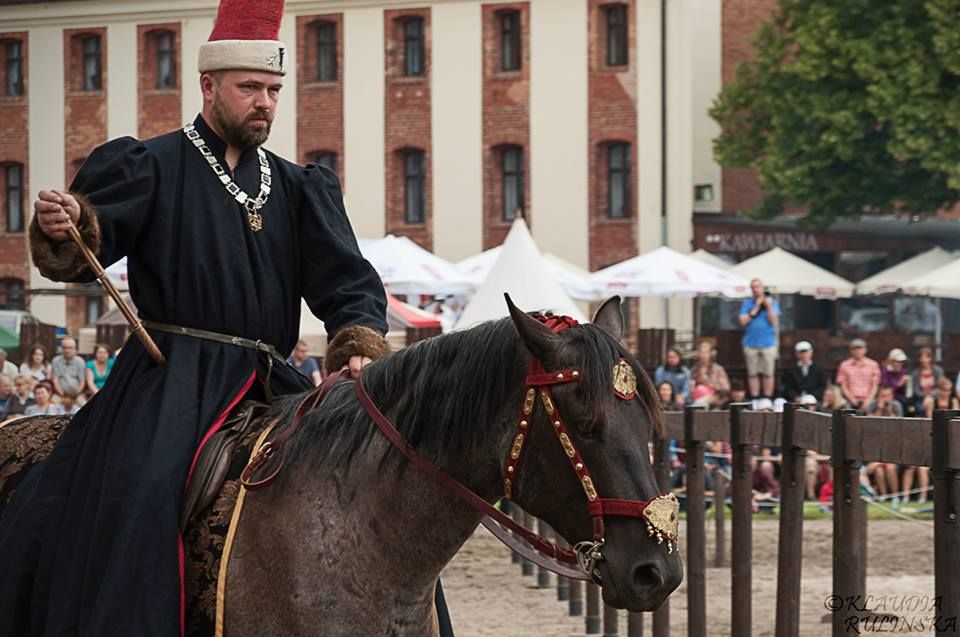
Jan Gradon, holding his Marshal's baton watches the joust at Zamek Gniew intently
(photo by Klaudia Rulinska)
Related articles:
Jarek Struczynski Wins the "Tournament of the Phoenix 2013"
Arundel Castle International Jousting Tournament 2013
An Interview with Jouster Mark Caple, Champion of the "Queen's Jubilee Horn Tournament 2014"
Hello Jan, please tell us a little about yourself.
I’ve been involved in historical re-enactment since 1996/7, but at first it was not that "historical". I got more into it around 2001, when I first traveled to England for the Battle of Tewkesbury and other events abroad, and then when I joined the Society of St. Michael Archangel (TaŚMA) in 2004 and my equestrian re-enactment group Xiazeca Druzyna in 2005.
With the group, we portray many periods, from Normans through 13th century knights and Rus warriors, early 15th century with the battle of Tannenberg, mid/late 15th century (we started jousting roughly in 2006/7), 17th century with Polish national cavalrymen and Finninsh Reiters, 2nd Ulhan Regiment of Grand Duchy of Warsaw from the Napoleonic Times to Polish cavalrymen of WWI. We also have a horse archery team within our group, that participates in horse archery contests. In the plans there are Romans too. The group trains due to massive help from our stables Pa-Ta-Taj near Warsaw. They train us also in "normal" riding – dressage, horse jumping, etc.

Jan Gradon, riding Briar, jousts Mark Caple at Arundel International Tournament 2013. In the bottom left is Jan's friend and squire, armourer Tomek Samula(photo by Richard Pearn)
From my past experience, the best equestrian memories I have are: Hastings 2006 where we were riding in Dom Sewell’s conroy, and I was riding his horse George [a 'conroy' is a name for a Norman cavalry troop]; my first international joust in Gniew Castle in 2008; winning of Tournament of the Phoenix 2011, and second place in 2013; Le Tournoi du Lys d'Argent in Canada in 2012 where I was unhorsed; and getting into the final (and losing by 1 point as a team, and receiving 2nd individual score) at Arundel International Tournament last year.
Besides jousting I do skiing in winter and do quite a bit of wargaming and painting miniatures. I enjoy a family life with my wife Ula and two daughters, Marysia and Zosia, and our border collie Gibon.
When and how did the Tournament of King John III get started?
The Tournament of King John III started in Gniew Castle in 1992. In 1994 the first mounted tournaments were organized, but at that time they were mainly for a show and only Mounted Skill at Arms contests. Twenty years ago, no one thought of doing jousting, as historical re-enactment was just starting in Poland. In 2007 the first jousting tournament was held, and since then it has grown bigger with higher equipment standards. This year it was the 23rd edition of the event, and the second tournament affiliated with WJT.
What makes Zamek Gniew a good location for a jousting tournament?
First of all, Zamek Gniew is a real castle, so it is always better to joust on a historical site. Secondly, it is an ideal place to organize an international tournament as it has everything on site: a four star hotel where competitors stay, a restaurant where they are fed, a hotel for all the ground and stable crew, a permanent tilt yard with recently covered stands for the public, permanent stables, armoury for the competitors and a fully equipped party hall to have fun in the evenings.
Who is allowed/invited to watch the tournament?
The tournament is open for the public, so anyone can come. On Fridays we usually hold training sessions, and they are free to watch. Saturday and Sunday are ticketed, but the prices are not very high, and as far as I know, residents of Gniew have a discount. There was a limited advertising this year, but we had around 2500-2800 spectators.
How did you become involved with organizing this year's tournament?
I was active around the Tournament since 2008 or 2009. Having traveled with Jarek Struczynski to various international events, we saw many things that we could change and include in our tournament. The first tournaments were more in the sport format with competitors in equipment from different periods (i.e. 14th century jousting with 15th century). Having participated in the Tournament of the Phoenix 2011, I came to an idea of organizing a strictly 15th century tournament in a similar format, where competitors have to participate in many contests to get the final prize. I shared that idea with Jarek, who approved it. I divided the work with Jarek. He and his team organized everything on site, preparing the premises, and I must admit they did an enormous job. My part was to organize and arrange everything with the competitors and ground crew.
In 2013, we organized the first tournament affiliated with WorldJoust Tournaments(WJT) and the International Jousting League(IJL) which involved 12 competitors! Unfortunately the weather was terrible, and not everything went smoothly. This year our second WJT tournament was moved in time to the end of June. The weather was perfect, and we were able to run all the contests.
How was the tournament organized this year?
This year we ran a team tournament with four international teams: England with Steve Mallett and Sean George, Norway with Petter Ellingsen and Per Estein Prois-Rohjell, Burgundy with Wouter Nicolai and Jeff Hedgecock, and last but not least, Poland with Michał Ruda and Adam Firyn.
First we held a Mounted Skill at Arms(MSA) competition. This was just for the MSA prize and the scores were not counted towards the team score. The MSA was won by Steve Mallett from team England.
For the Team prize, we were to count scores from Jousting (overall 6 sessions), mounted melee and crossbow. However, because the competitors did not have a chance to practice the crossbow before the contest, in the end we made it an individual competition that did not count towards the overall score.
As for jousting, we had each of the teams jousting with all the other teams. In each session, one team was jousting with another, and each competitor was to make 3 passes with each competitor from the other team. The scores were counted depending on the area hit (shield, armour), and breakage (attaint, full break). The Lady of Honour and the other Ladies could add 1 or 2 extra points to a total score of a team or individual if they liked his riding, behavior etc...

Lady of Honour Viktoriya Borisova wraps a token around the lance of Michel Ruda
(photo by Marta Kitta)
The mounted melee was watched by the Marshall, Knight of Mercy and Court of Ladies, and scores were applied under their opinion. In the end, all scores were put together, and England became the Team winner, Petter Ellingsen earned the Individual title, and Michał Ruda won the crossbow competition.
What can you tell me about the horses that were ridden in the tournament?
All the horses this year were provided by the Castle crew and Krystian Mróz, who was the Stable Master. They were various breeds, from Trakehner, Silesian, Polish Halfbred, and Shire cross breeds.
What were some of the most exciting/interesting moments during the tournament?
There were a lot of good, and strong hits. Quite a few lances broke in their solid parts. I must say that I cannot choose one exciting moment, as I’m very happy with the event as a whole.
Did anything exciting/interesting happen before or after the tournament?
On Thursday prior the event, we had a nice party during the day with a few drinks and laughs, and then Jarek Struczynski ordered us to mount up. Steve Mallett, Jeff Hedgecock, Sean George, as well as the Gniew team and I were dressed in 17th century Polish costumes, and we went for a ride onto the fields and forests on the banks of the Vistula River. Everything began calmly, and then Jarek ordered a flat out gallop. I hope this will be well remembered.
On Friday we had an excursion to Marienburg Castle – the capital of the Teutonic Order, which in my opinion is one of the most beautiful castles in Europe.
We also held a bareback melee, where we rode just in pants with no saddles, and were fighting with softer maces, and grappling was allowed. It did hurt a bit, but it was fun!

Luc Petillot(left) and Jan Gradon(right) compete in the bareback melee
(photo by Martin Hagen Johnsen)
After the Tournament, we also had a Mass with a Gregorian choir in the Castle’s chapel.
What can you tell me about the night jousting that took place by torchlight this year?

Jan Gradon, Luc Petillot and Adam Ałaszewski await the beginning of the Tournament of the Golden Rose(photo by StudioA)
It was not a part of the competition. We organize it annually as the Tournament of the Golden Rose. There is a local legend about a Golden Rose and its Protector. In the tournament, knights joust to get the Golden Rose, and the winner has to duel the Protector. This year we had Luc Petillot (Knight of Mercy during the day competition), Adam Ałaszewski from Gniew, and me as the knights, and Jarek Struczynski as the Protector of Golden Rose. It was a show, but the jousting was real. All done with bonfires, torches and nice music. I was very happy to do it, as I could try my new armour before this season (btw, huge thanks to Pelle for letting me use his helmet).
What is unique about the Tournament of King John III?
As I said to the Competitors during the briefing on Friday evening, the Tournament is mainly a social event, where people from different countries and cultures can meet, talk, have fun and break some lances. Jousting is a crucial part of the event, but it is very important to have fun. We definitely had fun… especially on Saturday night!
How does the tournament vary each year? What are some of the ways the tournament was organized in previous years?
We change the format annually. In the past it was mostly a foot combat. Then when the jousting started, we change from individual, to team, change the rules, etc..., but the spirit stays the same.
What would you like to say about/to this year's participants?
This year we had some Competitors that participated in the past (Jeff, Steve, Petter, Michal and Adam), and two new ones – Sean and Pelle.

Per Estein Prois Rohjell(aka Pelle) and Sean George exchange blows in the mounted melee
during their first competition at Gniew Castle(photo by StudioA)
The crew was Viktoriya Borisova as the Lady of Honour; Luc Petillot as Knight of Mercy; Jarek Struczynski as Field Coordinator; Stanislaw Szmit as the Herald; Krystian Mróz as Stable/Horse Master; Jakub Grybek, Leszek Struczyński, Darek Ostaszewski, Paweł Piotrowski as scoring judges; squires from Chełmno and Gniew; and me as the Marshal.
What are your hopes/plans for future tournaments at Zamek Gniew?
We will talk about it after this season ends. Next is Arundel International Tournament, where Jarek Struczynski and I will joust as team Kingdom of Poland! Wish us luck!
Best of luck at Arundel and in all your future jousts!

Jan Gradon, holding his Marshal's baton watches the joust at Zamek Gniew intently
(photo by Klaudia Rulinska)
Related articles:
Jarek Struczynski Wins the "Tournament of the Phoenix 2013"
Arundel Castle International Jousting Tournament 2013
An Interview with Jouster Mark Caple, Champion of the "Queen's Jubilee Horn Tournament 2014"

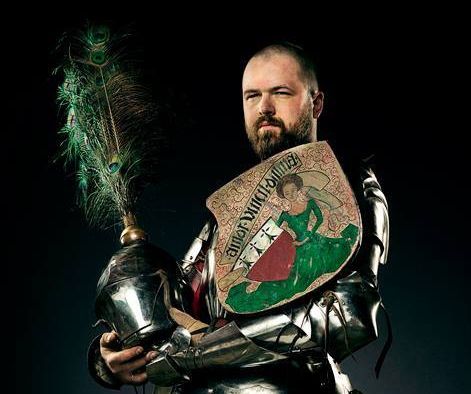
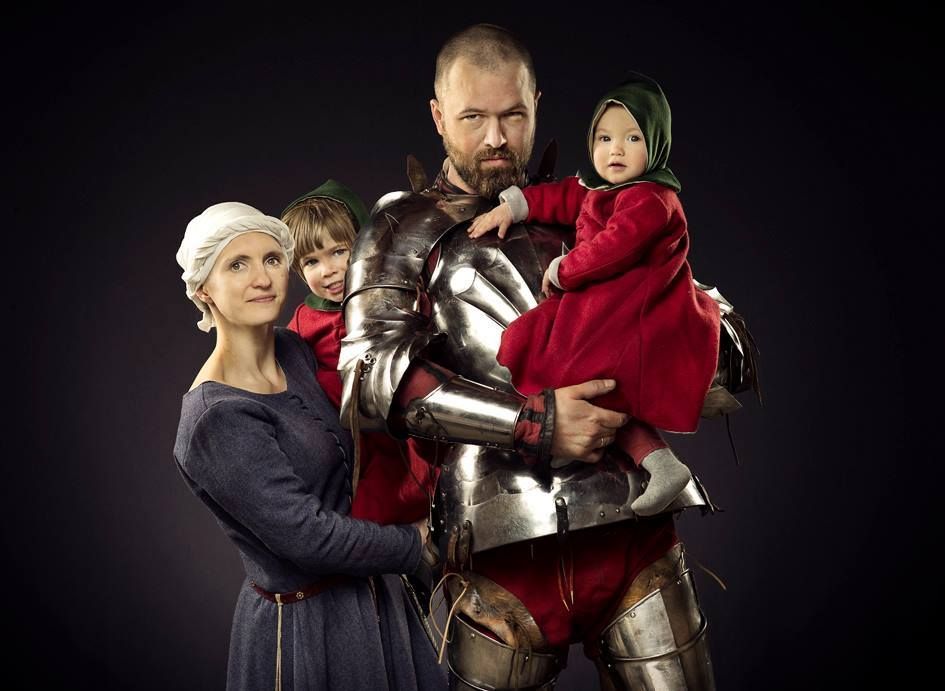
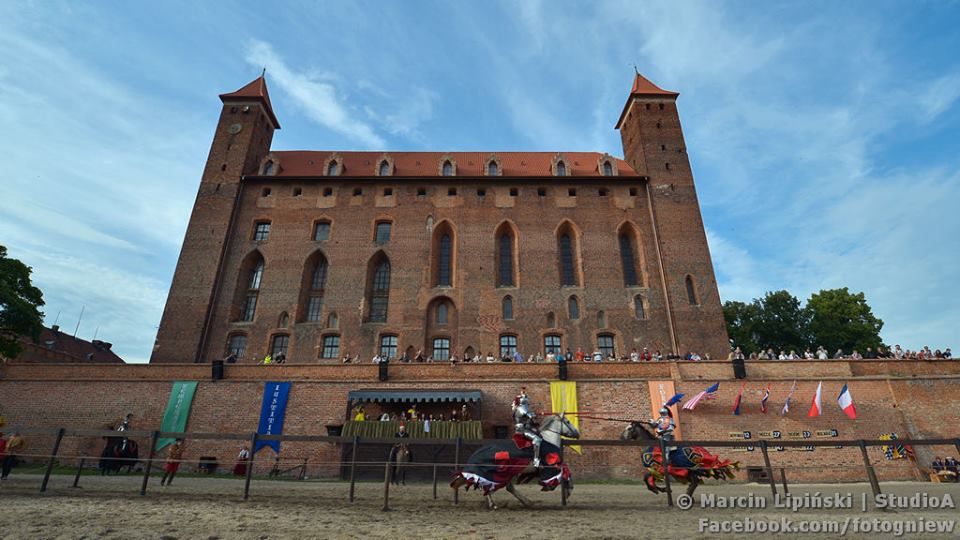
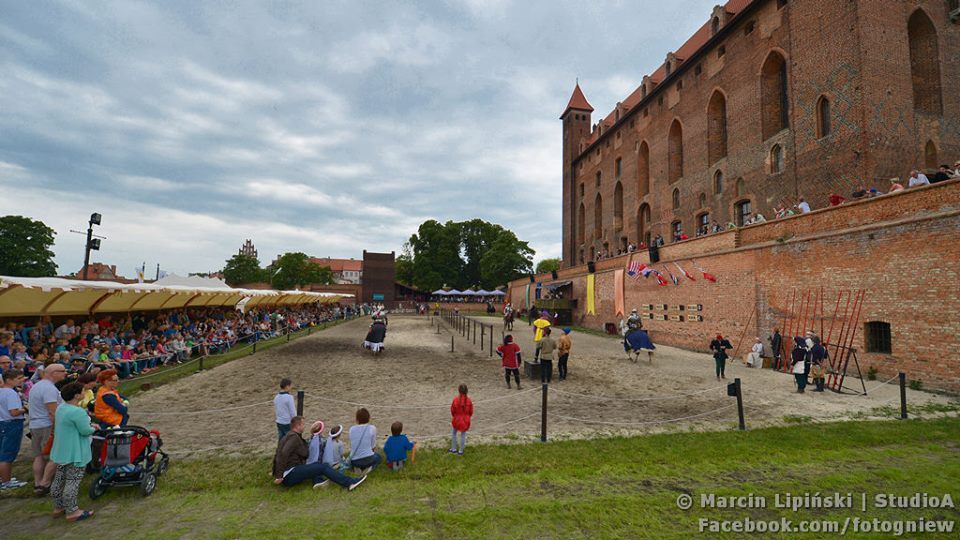
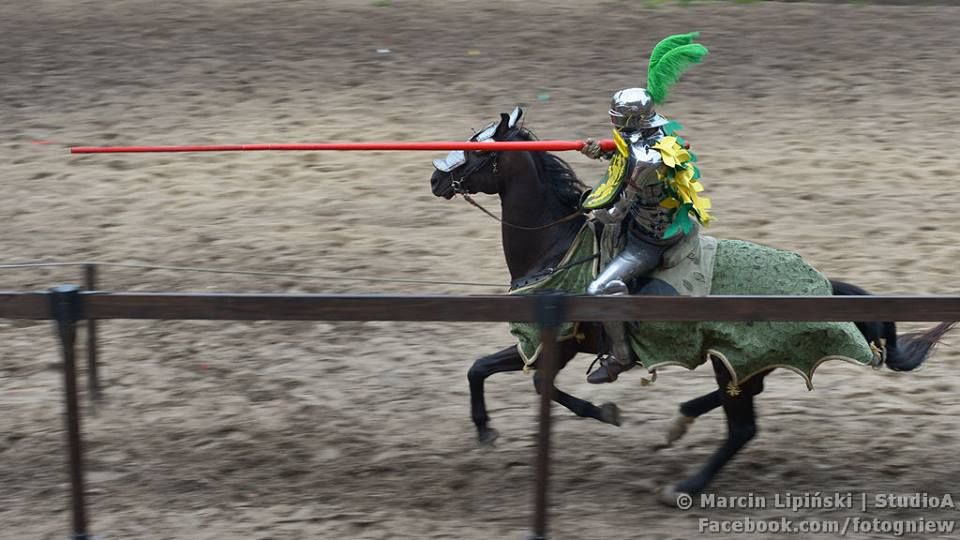
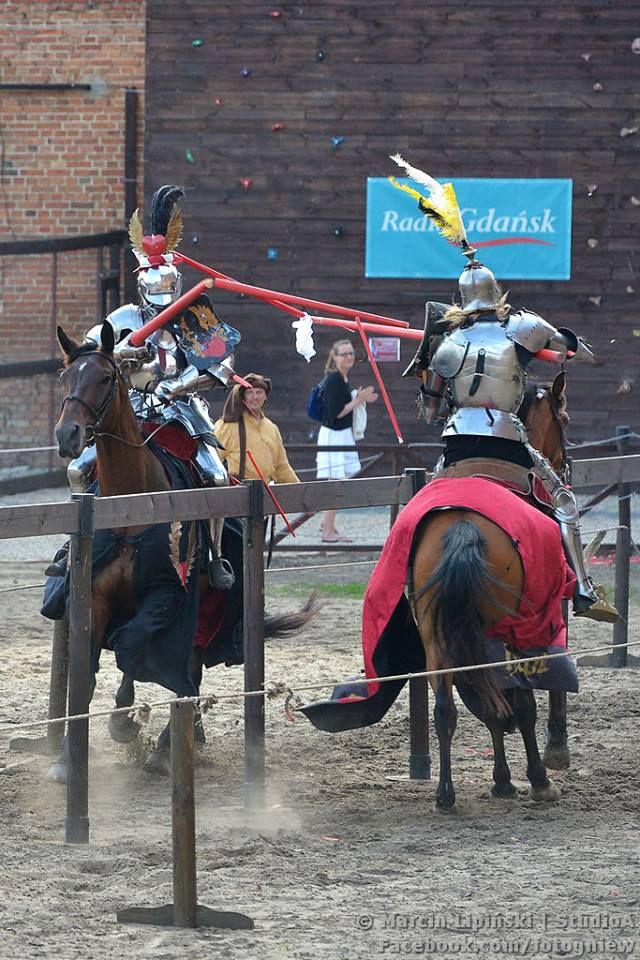
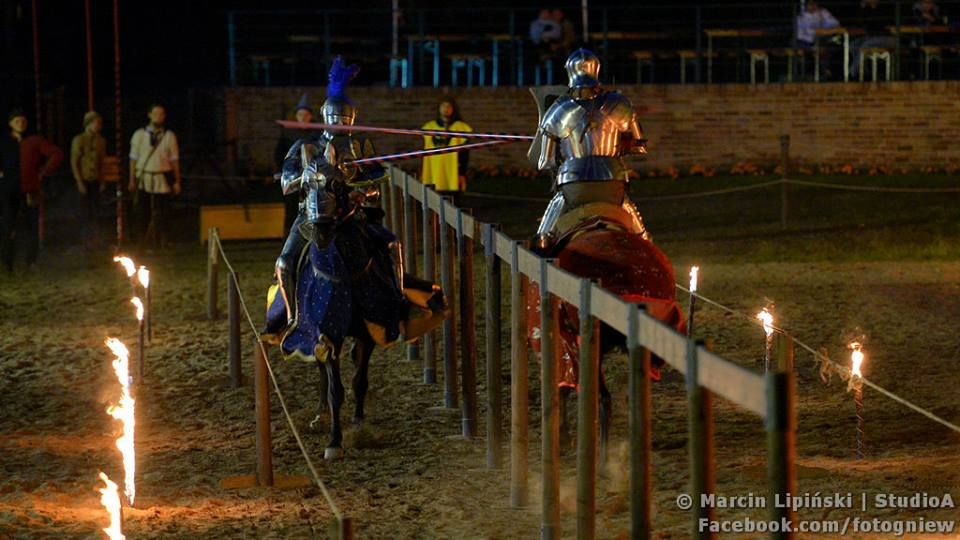
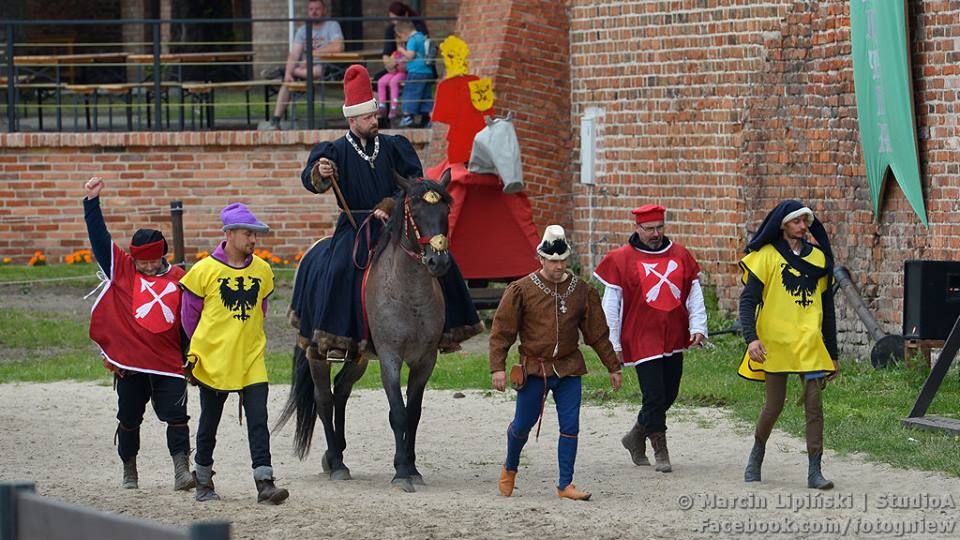
No comments:
Post a Comment